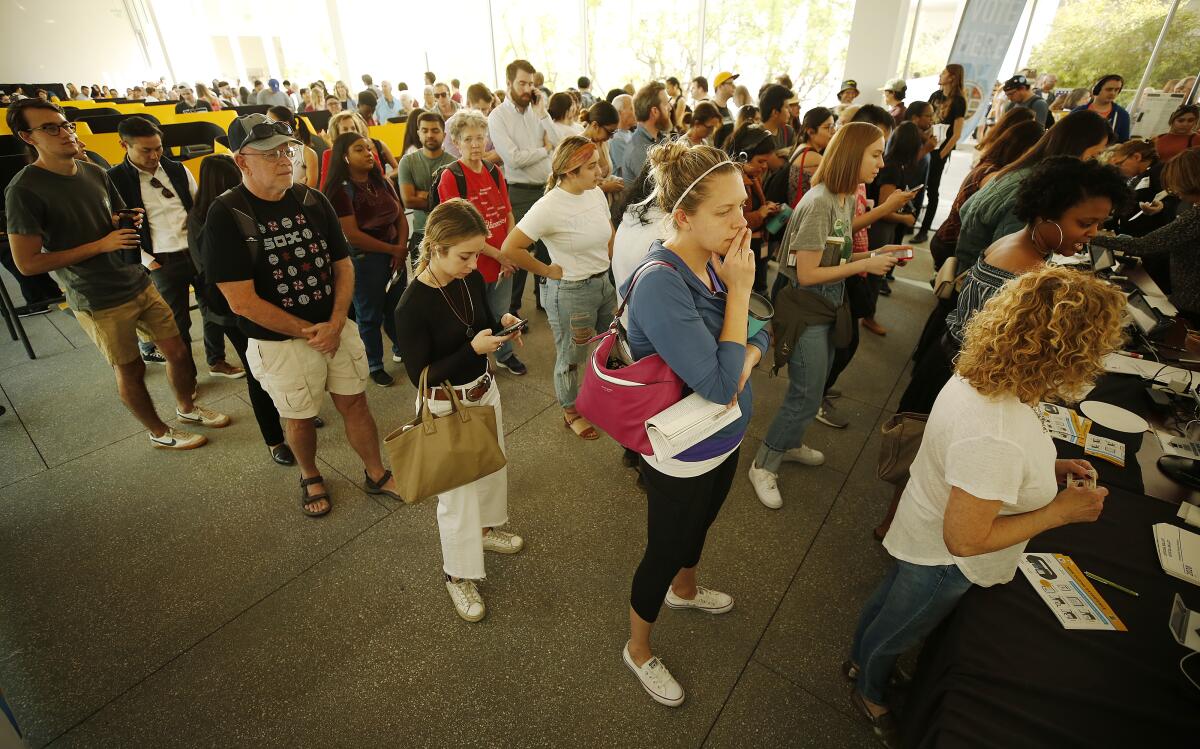Editorial: L.A. County’s new voting system wasn’t just glitchy on election day — it was totally unacceptable

A few unforeseen glitches are entirely reasonable with the deployment of any new technology, especially one as massive as the $300-million high-tech voting system that Los Angeles County rolled out to serve 5.2 million voters in the Tuesday election. Neighborhood polling places were replaced by fewer but strategically located vote centers. The old-school Ink-a-Vote machines gave way to sleek new touchscreens that printed individual ballots. Those upside-down sign-in books disappeared in favor of tablet computers connected to the voter registration database.
But what L.A. County voters experienced on election day was worse than just the expected bugs and hiccups of people getting used to something new. The brand-new ballot-marking machines and check-in tablets appeared to have malfunctioned in many vote centers, causing long lines. Many voters reported that the system couldn’t find their names, forcing them to cast provisional ballots. Some people simply gave up after spending hours in line and left without voting. We will never know how many people were disenfranchised by the chaos on Tuesday.
County Registrar-Recorder Dean Logan acknowledged that the lines were caused by a combination of high turnout and equipment problems, but he hasn’t said how many machines failed or how many of the 978 vote centers were affected Tuesday. He needs to provide details about which equipment failed and why, and then, more broadly, how it could have done so after a year of testing.
Furthermore, how did the high turnout catch his office flat-footed? They should have been ready for an onslaught of eager voters. Elections officials have known for months, if not years, that this primary would be one of the most well-attended in state history. California’s voter registration is at an all-time high. And we also knew from past experience that voters who were registered without a party preference, which is the second most numerous group of voters in the state, would need some extra help obtaining and submitting crossover ballots.
While he’s at it, Logan should explain how his office messed up the mail-in ballots sent out to voters in Pomona and Hawthorne. Those ballots did not include an option to vote for Measure FD, the parcel tax to raise money for emergency services. As a consequence, supplemental ballots had to be sent out.
We can’t help but notice that this is the third state primary in a row characterized by major problems at polling places in Los Angeles County. In June 2018, about 118,000 L.A. County voters were left off the rolls due to a software error and could only cast provisional ballots. Two years earlier, voters experienced myriad problems, including malfunctioning machines and untrained staff. This can’t keep happening.
The new system was supposed to fix those problems, and perhaps it has — but it also appears to have created new ones. That’s unacceptable.
County Supervisor Janice Hahn, a champion of Measure FD, called for a full investigation of the vote center problems. That’s a good start. We need answers about why things went so wrong in a system that was years in development and was designed to make voting easier and more convenient. But more than that, we need to hear and what steps will be taken to ensure this sort of thing won’t happen again. Even while they are demanding details about Tuesday’s failures, county supervisors might want also explore such bigger issues as whether allowing weeks of early in-person voting is worth the cost when so many people still waited until election day to cast a ballot and the possible security risks raised by the California Clean Money Campaign and others.
But perhaps most important, county supervisors should think hard about whether the registrar’s office has the right leadership going forward. There’s an even more consequential election coming up in eight months, and we can’t afford another failure of this magnitude.
More to Read
A cure for the common opinion
Get thought-provoking perspectives with our weekly newsletter.
You may occasionally receive promotional content from the Los Angeles Times.










